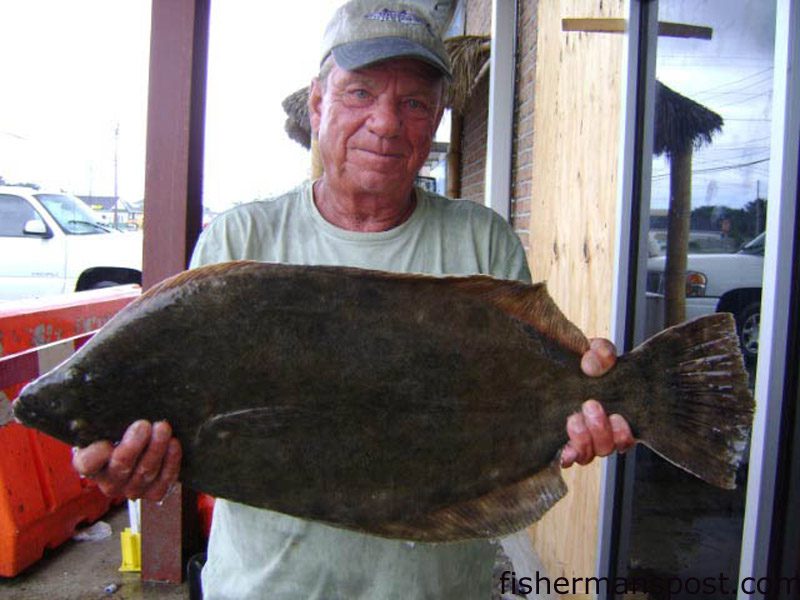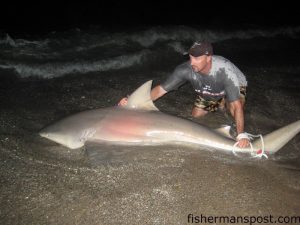Carolina Beach September 11, 2008

Ted Conner, of Carolina Beach, with an 11 lb. flounder that fell for a large live finger mullet in the ICW near Carolina Beach.
Seth, of Reel Bait and Tackle, reports that anglers are still catching flounder in the inlets, the ICW, and around the nearshore reefs, which have been producing some of the larger fish lately. Finger mullet or other small live baits fished on Carolina rigs with the weight adjusted to the water depth and current are top choices for the flounder.
Anglers are finding hungry red drum in the lower river bays, the creeks off the river and ICW, and on ICW docks and other structure. Finger mullet and other live baits, Gulps, topwater plugs, and other lures will all attract attention from the reds.
It’s also high time for the big, citation-class reds to start feeding on nearshore ledges and other structure, where anglers will likely encounter them while trolling for king mackerel or bottom fishing for flounder or gray trout. Several of the big reds have already been landed over recent weeks.
Spadefish are schooling up on nearshore structure. A few cannonball jellyfish (jelly balls) tied to a rope and dangled near the structure will get the spade’s attention. After tying the rope off to keep the fish near the boat, a small hook baited with a piece of the jelly ball should prove irresistible to the fish.
The spanish mackerel bite had been solid along the beaches before Tropical Storm Hanna, and the fish should return again when the water clears up. Trolled Clarkspoons fished along the beaches and around structure, working birds, or bait concentrations out to 50′ of water should produce action with the spanish.
Like the spanish, the king bite likely slowed down a little with the passing of the storm; however, as the weather stabilizes, anglers can expect to see kings feeding at many of the usual spots from the beaches to 100′. The king action will only get better as the water begins to cool off and bait flushing out the inlets draws the fish near the beaches. Live pogies, cigar minnows, and other baits are top choices for the largest kings.
Sailfish and dolphin have been mixed in with the kings 10 miles and further offshore, and anglers should see a few more of both fish before the season slows down.
The bottom fishing bite has been solid in recent weeks, and targeting structure 30+ miles offshore should produce action with a variety of bottomfish including beeliners, grunts, pinkies, and red and scamp grouper. Squid, cigar minnows, and cut baits are excellent choices for bottom baits.Bruce, of Flat Dawg Charters, reports that flounder fishing should still be decent in the inlets and waterway, with good numbers of fish on the nearshore reefs as well.
Soon, cooling water temperatures will get the big flounder on the move, and late September/October is one of the best times of the year to hook up with a giant flatfish. Live finger mullet and pogies on Carolina rigs are the best flounder baits.
The nearshore structure south of Carolina Beach Inlet is holding some gray trout. Anglers can hook them on Carolina rigs they’re fishing for flounder, or vertically jig with Stingsilvers to specifically target the grays.

Jo Ann with a 9 lb. flounder that fell for a live 6" mullet in Snow's Cut while she was fishing with Capt. John Batson of Batson Charter Boats. Photo courtesy of Island Tackle and Hardware.
Brad, of Fish Spanker Charters, reports that area bottom fishing has been excellent over the past few weeks. Structure in the 35-40 mile range has produced the most action, with anglers landing plenty of red grouper (some up to 20 lbs.), scamp, and a few gags (also up to 20 lbs.). The beeliners, grunts, and pinkies have been on the feed as well. Dropping cut squid and cigar minnows to the bottom will get the smaller fish excited, and anglers can then fish whole cigar minnows or cut baits for the larger grouper.
Some king mackerel have been feeding in the same areas, and a light-lined cigar minnow should produce action with the kings while anglers are bottom fishing.
Closer to shore, the spanish mackerel bite has been excellent lately. Trolling Clarkspoons will produce action with the smaller mackerel.
Fall fishing is just around the corner, and as good as the action is, it will only get better once the water temperatures start to fall.

Clint Rouse, of Wilmington, with a 9' long, 250 lb. (estimated) bull shark he caught in the Fort Fisher surf on half a 30 lb. amberjack he paddled out from the beach in a kayak.
Kiera, of Kure Beach Pier, reports that bottom fishermen are catching a few croaker and spot on shrimp.
